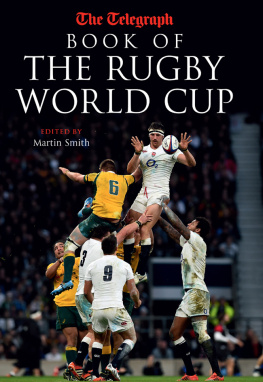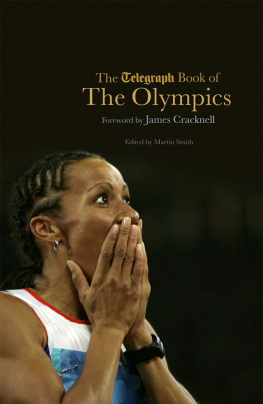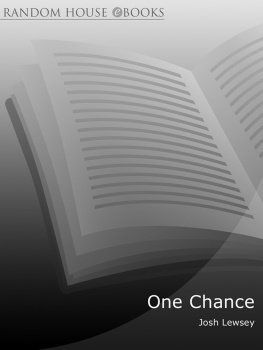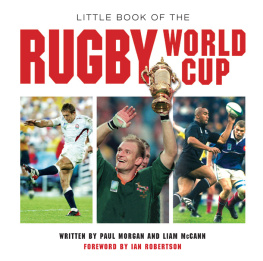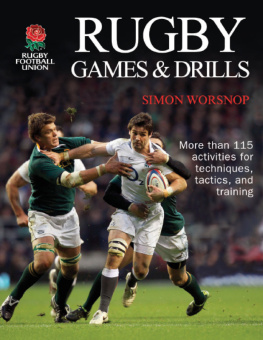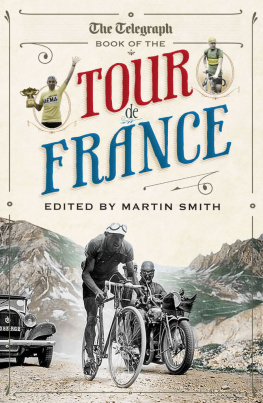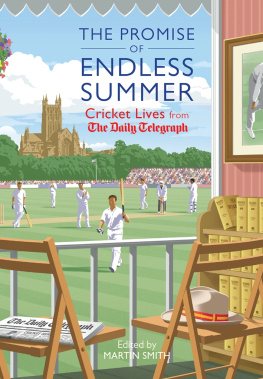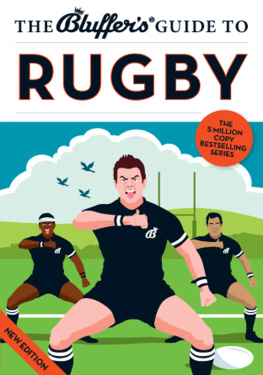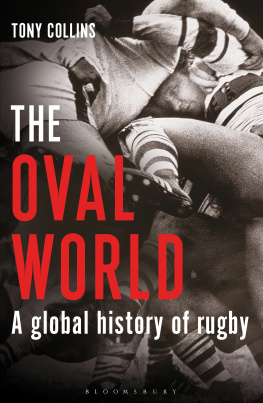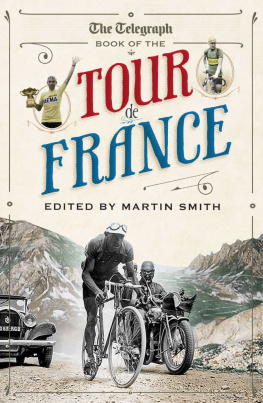Martin Smith - Telegraph Book of the Rugby World Cup
Here you can read online Martin Smith - Telegraph Book of the Rugby World Cup full text of the book (entire story) in english for free. Download pdf and epub, get meaning, cover and reviews about this ebook. year: 2015, publisher: Aurum, genre: History. Description of the work, (preface) as well as reviews are available. Best literature library LitArk.com created for fans of good reading and offers a wide selection of genres:
Romance novel
Science fiction
Adventure
Detective
Science
History
Home and family
Prose
Art
Politics
Computer
Non-fiction
Religion
Business
Children
Humor
Choose a favorite category and find really read worthwhile books. Enjoy immersion in the world of imagination, feel the emotions of the characters or learn something new for yourself, make an fascinating discovery.
- Book:Telegraph Book of the Rugby World Cup
- Author:
- Publisher:Aurum
- Genre:
- Year:2015
- Rating:5 / 5
- Favourites:Add to favourites
- Your mark:
- 100
- 1
- 2
- 3
- 4
- 5
Telegraph Book of the Rugby World Cup: summary, description and annotation
We offer to read an annotation, description, summary or preface (depends on what the author of the book "Telegraph Book of the Rugby World Cup" wrote himself). If you haven't found the necessary information about the book — write in the comments, we will try to find it.
Telegraph Book of the Rugby World Cup — read online for free the complete book (whole text) full work
Below is the text of the book, divided by pages. System saving the place of the last page read, allows you to conveniently read the book "Telegraph Book of the Rugby World Cup" online for free, without having to search again every time where you left off. Put a bookmark, and you can go to the page where you finished reading at any time.
Font size:
Interval:
Bookmark:

For my son, William, a decent fly-half/full-back in his youth in appreciation of some memorable tries and place-kicks, if not the too-frequent visits to A&E.
CONTENTS
I t may seem a tad unconventional to begin a word-heavy book by talking about photographs. However, once the last dropped goal has gone over, the trophy has been presented and the large soprano has stopped singing, what are we left with but our memories? As the eighth tournament approaches, The Telegraph Book of the Rugby World Cup will attempt to stimulate the old grey cells, as well as tell the story of what the overexcited organisers call the third-biggest sporting event on Earth. Hopefully the words of the Telegraphs army of rugby writers rolled out here will conjure up, pass by pass, a half-forgotten try, add colour and insight to a famous moment, while you sit back and enjoy your own nostalgia.
Let us start, though, by flicking through a virtual photograph album of iconic images. The stand-out picture of any World Cup is surely that of Nelson Mandela handing over the Webb Ellis trophy to the victorious Springbok captain Francois Pienaar in 1995. Normally a presentation picture is so bog-standard and dull that it would be hidden away in the backwaters of a newspapers coverage. Not this one; this one had a context way beyond the confines of a rugby stadium in Johannesburg, way beyond sport itself. Conjure up the picture in your minds eye. It shouldnt be difficult it has been used everywhere from newspapers, books and magazines to posters for the movie Invictus. It shows a beaming white player, fresh from the action, shaking hands with an elderly black guy, decked out in a replica green-and-gold shirt of the other, topped off with a green baseball cap, his smile just as wide. The new, post-apartheid South Africa had been born in monochrome five years earlier with the release from prison of the now President Mandela; the vibrant colours of the emerging Rainbow Nation were painted in as the united country burst with pride at its first international sporting success.
The Sunday Telegraph sports supplement carried the picture tip-to-toe on its broadsheet front page, under the headline: The waiting is over. Inside, on page two, the sport itself was celebrated in a shot by staff photographer Russell Cheyne (of whom more soon) of the moment the cup was won. The ball has just left Joel Stranskys boot as he drops the winning goal deep into extra time. As it flies past Andrew Mehrtenss attempted block it almost looks as if the New Zealand fly-half is surrendering. A thousand words told in the click of a cameras shutter.
The front page of the main paper that June Sunday included a single-column portrait of a still-smiling Mandela raising his cap, atop a story signalling the sport sections coverage. The news people had weightier matters with which to concern themselves when it came to that days splash. And, twenty-four hours later, so did the Dailys sports desk. Bar a small news-based story from the World Cup final, the cover of the sports pull-out was dominated by Phil Browns shot of Darren Goughs middle stump being ripped out of the ground by West Indies fast bowler Curtly Ambrose in the Lords Test. Just as life moves on, so too does sport.
That third edition of the World Cup, back in 1995, was comparatively prolific in the number of memorable images it produced. The Daily Telegraph Monday sports section was particularly fortunate in the fortnight before cricket reclaimed its place to publish two of the very best, both taken again by Russell Cheyne, the reigning rugby photographer of the year. The first, on 12 June, underneath the headline Englands dream finish, was of Rob Andrew drop-kicking the decisive points in the quarter-final against Australia. A smile is already forming on Andrews face as he follows the balls path. At the same time you can see the despair on the faces of Michael Lynagh and David Wilson as they rush in too late to prevent the impending damage. The image was so powerful that the paper replicated it a few days later, along with a letter from Anthony Robinson of Newark, Nottinghamshire, in which he said: The combined results of the work of Russell Cheyne and your production team gave your readers on Monday the finest piece of triumphal sporting photography I have ever seen. The front page of the sport section is a glittering example of pictorial journalism and will make the occasion it celebrates ever more unforgettable. The marketing department werent slow in recognising the value of the moment that will go down in rugby history. They responded by offering readers by popular demand the opportunity to purchase a poster replica of the front page. You may still have a copy on your bedroom wall.
However, as in politics, so in sport: what a difference a week can make. The following Mondays front page was dominated by a full-length picture of Jonah Lomu charging away to score the second of his four tries in the All Blacks semi-final mauling of England. Lomu is heading straight towards Cheynes lens; you can see the power of his six-foot, five-inch, eighteen-and-a-half stone frame, and you want to duck underneath the breakfast table to avoid the inevitable collision. And there, sprawled full-length in the background, grasping at thin air after failing to lay a hand on the man mountain, is the previous weeks hero: Rob Andrew. The headline says it all: Bulldozed by Lomu. Indeed.
If Lomu was Englands nemesis in 1995, and again four years later, then a slighter, lighter, leaner figure was launched in time to wreak vengeance on the world in 2003: Jonny Wilkinson. All right, opposing backs might not be thumbing through the small print in their health insurance in trepidation, but allow him within range of a kick, dropped or placed, and you were kissing goodbye to three points. Maybe not bulldozed, but Jonnys accumulated points in a match could be every bit as devastating as a quartet of Lomu tries. The mere mention of his name brings up an instant image of that trademark hunched stance, hands together as if praying, or perhaps preying, while he prepares to kick yet more points for England.
Wilkinson was top scorer at the 2003 Rugby World Cup with 113 points. But it was the kick that took him from 110 to 113 that left an indelible imprint in the mind of every red-bloodied, white-shirted England rugby supporter: the last-minute drop at goal that clinched the trophy in Sydney. Who cannot picture the moment? Chris Barry, a regular Telegraph freelance photographer, captured it perfectly for the front page of the Sunday paper. So perfect, in fact, that the Daily repeated it on an inside page the following day. There is Jonny, in textbook follow-through, as his kick continues its trajectory towards the gap between the posts. The headline? The Best, in capital letters; no simply about it. The photograph that led the front of the main paper that Sunday morning was a few frames later as Wilkinsons arms are raised aloft to acknowledge the safe passage of the kick. Twenty-four hours later, the first flush of success over, the front-page shot was of Wilkinson surrounded by a forest of tape recorders ready to capture his every celebratory utterance. A media star was born.
Wind the mental camera on eight years, two tournaments and a hop across the Tasman Sea from Australia to New Zealand. The images become a bit fuzzy and grainy, and aptly so: they are not taken by top-end photographers with expensive kit. These are the type of snaps taken with a mobile-phone camera. Members of the England squad are on a pre-tournament night-out in a Queenstown bar, which is holding a Mad Midget Weekender. This becomes, in journalese, a dwarf-throwing contest, and England players appear to be indulging in the competition as well as the local ale. The resulting pictures found their way back to the other side of the world and into every newspaper in Britain. One of those subsequently punished for his involvement was Mike Tindall, newly married to the Queens granddaughter. Then, to make it even worse, Englands premature exit from the tournament was marked by a photograph of a contrite Manu Tuilagi, who had been fined by the management for jumping off a ferry in Auckland harbour and swimming to the landing point. Embarrassing to the end ran the
Next pageFont size:
Interval:
Bookmark:
Similar books «Telegraph Book of the Rugby World Cup»
Look at similar books to Telegraph Book of the Rugby World Cup. We have selected literature similar in name and meaning in the hope of providing readers with more options to find new, interesting, not yet read works.
Discussion, reviews of the book Telegraph Book of the Rugby World Cup and just readers' own opinions. Leave your comments, write what you think about the work, its meaning or the main characters. Specify what exactly you liked and what you didn't like, and why you think so.

